Ladies Visiting and Travelling Outfits 150 T and 151 T - 1900
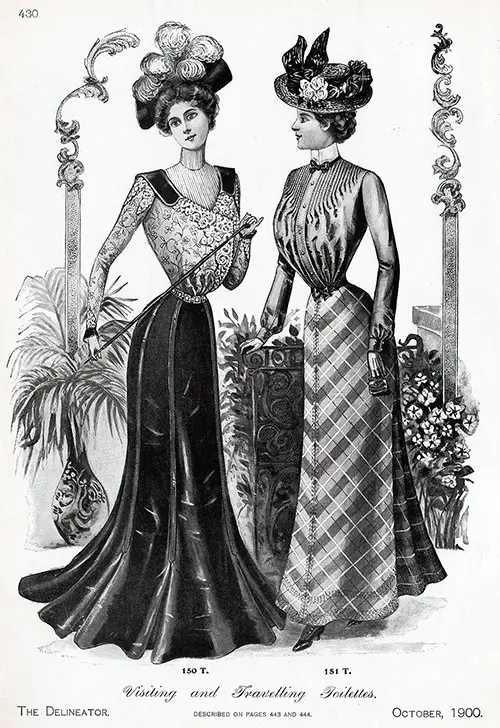
Visiting and Travelling Costumes 150 T and 151 T
Described on Pages 443 and 444 | Illustrations on Page 430
Ladies’ Ladies’ Visiting Costume No. 150 T
This unites a Ladies’ Basque-blouse and skirt.
Description
The costume is appropriate for dressy semi-formal occasions. The blouse is a new design sans revers, and in the present instance is shown developed in figured silk in combination with dark panne velvet and plain tucked silk, and a unique arrangement of lace decorates the mode stylishly.
The fronts and back of the blouse are shaped to display the yoke and are perfectly smooth at the top. Slight plaited fulness appears at the bottom of the back, and the fronts, which overlap broadly and puff out stylishly, are gathered at the lower edge.
A broad effect is induced at the shoulders by a smooth bertha that flares at the front and back. The close-fitting sleeves are completed with circular cuffs that fall over the hand, and a standing collar finishes the neck.
The seven-gored skirt used satin Duchesse in development, fully described in Figure No. 147 T.
Dressmaker Options
A beautiful costume could be made in this style of peau de soie combined with all-over lace and velvet.
Broadcloth, taffeta, mohair, Cheviot, tweed, vailing, cashmere, etc., will develop the skirt stylishly, while plain and fancy silk and satin, vailing and other light-weight woolen materials in combination with chiffon, mousseline, all-over lace, or decorative tucking will attractively reproduce the blouse.
Pattern Information
The blouse pattern, which is No. 4445 and costs 10d. or 20 cents, is in nine sizes for ladies from thirty to forty-six inches, bust measure, and may be seen differently developed on page 448.
The skirt pattern, which is No. 4397 and costs 1s. or 25 cents, is in nine sizes from twenty to thirty-six inches, waist measure, and is shown again on page 455.
Ladies’ Basque-Blouse or Bodice No. 4445
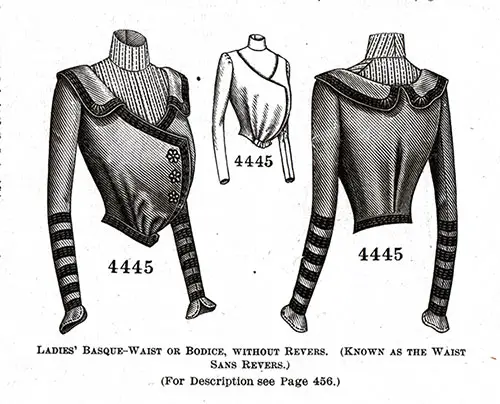
No. 4445 Ladies’ Basque-Blouse or Bodice without Revers. (Known as the Blouse Sans Revers.)
Description on Page 456 | Illustrations on Page 448
Another illustration of this blouse is shown in figure No. 150 T in this number of The Delineator.
Description
A combination of tucked white silk and light-brown lady’s cloth was tastefully employed in the present development of the design, which is simple and exceptionally stylish. Black velvet in stitched folds and fancy buttons provides useful decoration.
The fronts and back are shaped low to reveal the yoke, which closes along the left shoulder and is topped by a standing collar. The fronts overlap broadly and puff out with fashionable gathered fulness at the bottom.
The back is smooth at the top, but at the lower edge has slight fulness laid in small plaits at the center. The mode is sans revers but is given a stylish and becoming appearance by the bertha, which is in two sections and flares attractively.
The close-fitting sleeves are in two-seam style completed with flared cuffs, and a dart-fitted lining gives the blouse easy adjustment. A shaped belt defines the lower edge of the bodice, which dips stylishly in front.
Dressmaker Options
A variety of fashionable silk and woolen materials will develop the mode attractively. A stylish blouse could be made of voile with fancy tucking or all-over lace for the yoke.
Pattern Information
We have pattern No. 4445 in nine sizes for ladies from thirty to forty-six inches, bust measure.
To make the Basque-blouse for a lady of medium size, needs a yard and a half of fabric fifty inches wide with five-eighths of a yard of silk tucking twenty inches wide for the yoke and collar, and five-eighths of a yard of velvet in the same width (cut bias) for the belt and for bands to trim.
Price of pattern,10d. or 20 cents.
Ladies’ Seven-Gored Flare Skirt No. 4397
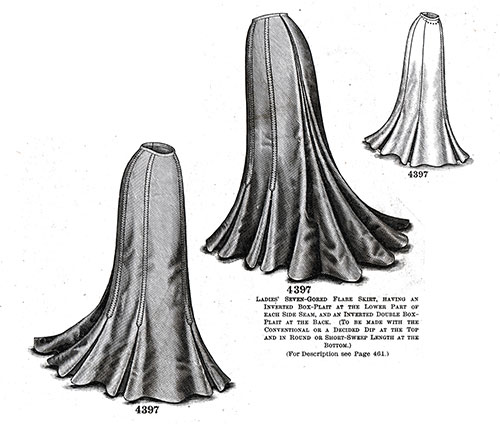
No. 4397 Ladies’ Seven-Gored Flare Skirt, having an Inverted Box-Plait at the Lower Part of each Side Seam, and an Inverted Double Box- Plait at the Back.
To be made with the Conventional or a Decided Dip at the Top and in Round or Short-Sweep Length at the Bottom.
Description on Page 461 | Illustrations on Page 455
This skirt may be seen again by referring to figures Nos. 147 T and 150 T in this number of The Delineator.
Description
The desirable flare produced by the introduction of an inverted box-plait at the lower part of each side seam and the sheath effect at the top are pronounced characteristics of the seven-gored skirt developed in zinc-colored cloth with self-strappings for decoration.
The skirt is shaped to fit perfectly smooth at the top without the use of darts and may have the conventional or decided dip in front, according to individual fancy.
The fullness at the back is arranged in an inverted double box-plait that falls in graceful folds to the lower edge, where the skirt falls in an outline of about four yards in the medium sizes. The skirt may be in round or short-sweep length.
Dressmaker Options
A fashionable skirt may be developed in magenta wool poplin with a decoration of black guipure. Mohair, serge, Cheviot, English suiting, homespun, Venetian, and Jady’s cloth, are appropriate for reproduction by the mode.
Pattern Information
We have pattern No. 4397 in nine sizes for ladies from twenty to thirty-six inches waist, or thirty-seven to fifty-eight and one-half inches hip measure.
To make the skirt of material with figure or nap, not including strappings, for a lady of twenty-four inches waist or forty-one inches hip, needs six yards forty-four inches wide; including strappings to trim, five yards and one-half fifty inches wide.
For materials without figure or nap, not including strappings, it needs four yards and one-half forty-four inches wide; including strappings to trim, four yards and one-eighth fifty inches wide.
Price of pattern, 1s. or 25 cents.

Ladies’ Travelling Costume No. 151 T
Ladies’ Travelling Costume is comprised of a Ladies’ shirt-waist and skirt.
Description
The general usefulness of the shirt-waist has been proved, and the comfortable garment seems to have attained a permanent position in the modern woman’s wardrobe.
Simplicity is a characteristic of the shirt-waist forming part of the costume here illustrated. Small, lengthwise tucks are taken up in groups at the center of the back, and the fronts, which puff out stylishly, are distinguished by pleats taken up at the top to graduated yoke depth.
The bishop sleeves are of the newest shaping; they are slashed at the wrists and completed with straight cuffs, and a white linen collar and string tie are worn. Gray French flannel was used in the development of the shirt-waist, and machine-stitching supplies the finish.
The skirt, as shown, is in instep length, but may be shorter, if liked, and for its development, a pretty Scotch plaid, cut on the bias, was chosen. It is in a two-piece style shaped with a seam at the center both front and back and is fitted perfectly close at the top by darts.
An inverted box-plait disposes of the fulness at the back, and the skirt shows the popular dip at the top. The mode is equally desirable for pattern fabrics and plain fabrics and is practical for developing serviceable skirts for shopping, touring, cycling, golfing, ice skating, stormy-weather wear, etc.
Dressmaker Options
A serviceable skirt could be made of double-faced covert cloth, while for the shirt-waist taffeta, poplin, fine serge, cashmere, or brilliantine may be appropriately selected.
Pattern Information
The shirt-waist pattern, which is No. 4427 and costs 10d. or 20 cents, is in nine sizes for ladies from thirty to forty-six inches, bust measure, and is also portrayed on page 449.
The skirt pattern, which is No. 4448 and costs 10d. or 20 cents, is in nine sizes from twenty to thirty-six inches, waist measure, and is pictured differently developed on page 462.
Ladies’ Shirt-Waist or Blouse No. 4427
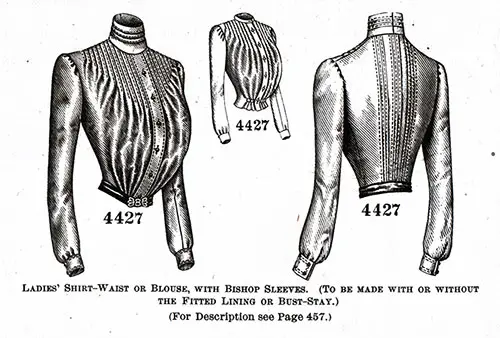
No. 4427 Ladies’ Shirt-Waist or Blouse with Bishop Sleeves. (To be made with or without the Fitted Lining or Bust-Stay.)
Description on Page 457 | Illustrations on Page 449
This shirt-waist may be seen differently made up by referring to figure No. 151 T in this magazine.
Description
For general wear, no garment can surpass the convenient shirt-waist or waist, and, if elaborately developed, it may be worn on dressy occasions. The mode here illustrated reproduced in light-blue taffeta is incredibly attractive.
The pouching fronts have their fulness taken up in small graduated tucks to pointed yoke depth at the top and in the gathers at the waist. The back is fitted smoothly at the sides and has fullness at the center arranged in three lengthwise groups of delicate tucks that extend from the neck to the waist.
The shirt-sleeves are in one-seam bishop style and vary from the conventional bishop sleeve in being slightly curved at the lower edge to deepen at the outside of the arm; they are completed with wristbands, closed below small openings at the back of the arm that are finished with consecutive laps.
A narrow band appears at the neck, and to it is attached a removable standing collar that has three tucks taken up at the top and closed at the back.
The pattern provides for a lining adjusted with single bust darts, and a seam at the center of the back and under each arm, and a bust-stay, the use of either being optional.
Dressmaker Options
An attractive blouse could be made of figured silk, showing yellow and white, and with it could be worn a soft shirred white chiffon stock and a belt of gold braid with a gold filigree clasp.
Challis, Henrietta, albatross, fine flannel, China silk, Lansdowne, etc., are also appropriate for the development, and any of the numerous fancy scarfs shown in the shops may replace the stock provided in the pattern. The blouse is a style suited to general wear and for traveling.
Pattern Information
We have pattern No. 4427 in nine sizes for ladies from thirty to forty-six inches, bust measure.
To make the shirt-waist for a lady of medium size needs three yards and one-half of fabric twenty inches wide.
Price of pattern, 10d. or 20 cents.
Ladies’ One or Two-Piece Circular Skirt No. 4448
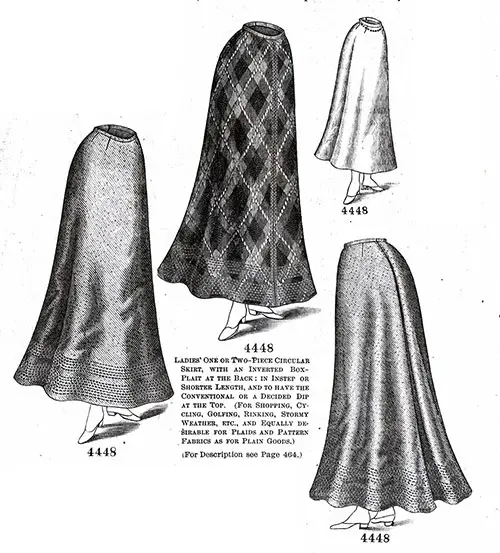
No. 4448 Ladies’ One or Two-Piece Circular Skirt with an Inverted Box- Plait at the Back: in Instep or Shorter Length, and to have the Conventional or a Decided Dip at the Top.
For Shopping, Cycling, Golfing, Ice Skating, Stormy Weather, etc., and Equally desirable for Plaids and Pattern Fabrics as for Plain Goods.
Description on Page 464 | Illustrations on Page 402
Other illustrations of this skirt are shown in figures Nos. 151 T and 159 T in this magazine.
Description
The practical woman recognizes the benefits to be obtained from wearing the slightly shortened skirt, and, in consequence, this useful garment is not only an acknowledged but a necessary part of the well-ordered outfit.
A skirt that will be sure to meet with appreciation is shown made of cloth. In one instance the material is plain and in the other plaid, stitching giving the finish in both cases.
The mode is of circular shaping and is cut in one-piece but may be in two-piece style with a seam at the center of the front and back, if preferred.
A dip at the top of the front that may be conventional or more pronounced distinguishes the skirt, which is dart-fitted over the hips and has fullness at the back laid in an under-folded box-plait that is stitched for a short distance.
The skirt ripples with becoming fulness at the lower edge, where it measures about three yards in the medium sizes and may be made in instep or shorter length.
The mode is a particularly desirable one for touring, shopping, stormy weather wear and for outdoor sports of all descriptions and is equally beneficial for plaids and pattern fabrics as for everyday materials.
Dressmaker Options
For golfing skirts, the favorite color is a very dark iron-gray or black. Oxford suiting will develop the mode stylishly.
Pattern Information
We have pattern No. 4448 in nine sizes for ladies from twenty to thirty-six inches waist, or thirty-seven to fifty-eight and one-half inches hip measure.
For a lady of twenty-four inches waist or forty-one inches hip, the one-piece skirt needs two yards and seven-eighths of fabric fifty-eight inches wide; two yards and three-fourths of material in the same width will be needed for the two-piece skirt.
Price of pattern, 10d. or 20 cents.
"Descriptions of Figures in Colors, Tints, Etc., Shown on First Page of Cover and Pages 423 to 437 Inclusive," in The Delineator: An Illustrated Magazine of Literature and Fashion, Paris-London-New York: The Butterick Publishing Co. Ltd., Vol. LVI, No. 4, October 1900, p. 402, 430, 443-444, 448-449, 455-457, 461-462, 464.
Editor's Note: Some terminology used in the description of women's clothing during the 1800s and early 1900s has been changed to reflect more modern terms. For example, a women's "Toilette" -- a form of costume or outfit has an entirely different common meaning in the 21st century. Typical terms applied to "toilette" include outfit, ensemble, or costume, depending on context.
Note: We have edited this text to correct grammatical errors and improve word choice to clarify the article for today’s readers. Changes made are typically minor, and we often left passive text “as is.” Those who need to quote the article directly should verify any changes by reviewing the original material.
Vintage Travel Outfit Fashions
GG Archives
Vintage Travel Outfit Fashions
- Ladies Visiting and Travelling Outfits 150 T and 151 T - 1900
- Ladies' Summer Holiday Fashions for 1912
- Ladies Fine Fashions for Ocean Liner Travel - 1921
- Ladies Wraps on Board the Steamships - 1921
- Ladies First Class Fashions For Days at Sea - 1922
- Lady Duff-Gordon’s Famous Curate Costume - 1917
- Wave of Fashion on Steamships - 1924
- Wave of Fashion on Steamships - 1925
Vintage Fashion Topics
Updates and Social Media
- Visit our GG Archives Vintage Fashions Facebook Page for the Latest News About the Activities of the Archives.
